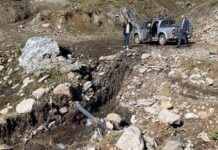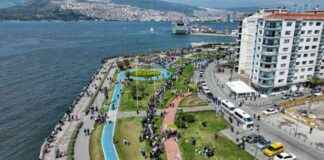President Erdogan’s Visit to ‘Hagia Sophia Photos’ Exhibition
President Recep Tayyip Erdogan recently visited the “Hagia Sophia Photos” exhibition, showcasing photographs taken by the talented artists Izet Keribar and Mehmet Özçay. The exhibition comes in the wake of the reopening of the Hagia Sophia as a mosque, a significant event that has sparked both celebration and controversy.
During his visit to the exhibition held at the Presidential National Library’s Reception Hall, President Erdogan took the time to admire the photographs and learn more about the stories behind each image. The photographs captured by Keribar and Özçay offer a unique perspective on the Hagia Sophia, highlighting its timeless beauty and historical significance.
Accompanying President Erdogan during his visit were esteemed guests including Minister of Culture and Tourism Mehmet Nuri Ersoy, President of Religious Affairs Ali Erbaş, and President of the Council of Higher Education (YÖK) Erol Özvar. The presence of these dignitaries underscored the importance of the exhibition and its role in promoting cultural heritage and artistic expression.
Subheadings:
Exploring the Exhibition: President Erdogan’s Engagement with the Photographs
The Significance of the Hagia Sophia: A Symbol of Cultural Heritage
Controversy and Celebration: Reactions to the Reopening of the Hagia Sophia
Exploring the Exhibition: President Erdogan’s Engagement with the Photographs
As President Erdogan walked through the exhibition hall, he paused at each photograph, taking in the intricate details and vibrant colors captured by Keribar and Özçay. The artists’ skillful use of light and composition brought the Hagia Sophia to life, showcasing its architectural grandeur and spiritual essence.
President Erdogan’s interest in the photographs demonstrated his appreciation for art and culture, as well as his deep connection to the Hagia Sophia. Each image told a story, conveying the rich history and cultural significance of this iconic landmark. The exhibition served as a visual tribute to the Hagia Sophia, allowing visitors to experience its beauty and majesty through the lens of talented photographers.
The Significance of the Hagia Sophia: A Symbol of Cultural Heritage
The Hagia Sophia holds a special place in the hearts of many, serving as a symbol of cultural heritage and religious identity. Originally built as a Christian cathedral in the 6th century, it was later converted into a mosque during the Ottoman Empire and eventually transformed into a museum in the 20th century. The recent decision to reopen the Hagia Sophia as a mosque has reignited debates about its historical legacy and cultural significance.
For many, the Hagia Sophia represents a bridge between East and West, a testament to the blending of different cultures and religions. Its stunning architecture, featuring a mix of Byzantine and Ottoman elements, reflects the complex history of Istanbul and the diverse influences that have shaped the city over the centuries. By visiting the exhibition, President Erdogan paid tribute to this rich heritage and celebrated the enduring legacy of the Hagia Sophia.
Controversy and Celebration: Reactions to the Reopening of the Hagia Sophia
The decision to reopen the Hagia Sophia as a mosque has sparked a mix of reactions, with some celebrating the return of the site to its religious roots and others expressing concern about the implications for cultural heritage and religious tolerance. The exhibition of photographs by Keribar and Özçay offered a platform for reflection and dialogue, inviting visitors to engage with the complex issues surrounding the Hagia Sophia’s reopening.
President Erdogan’s visit to the exhibition highlighted the importance of art in fostering understanding and appreciation of cultural heritage. By engaging with the photographs and learning about the stories behind each image, he demonstrated his commitment to promoting artistic expression and preserving Turkey’s rich historical legacy. As discussions continue about the future of the Hagia Sophia, the exhibition serves as a reminder of the enduring beauty and significance of this iconic landmark.





















